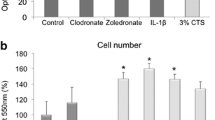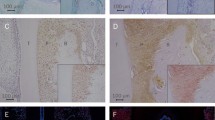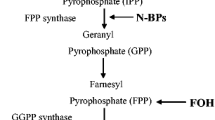Abstract
Bisphosphonates (BP) are used in the treatment of malignant osteolytic processes and postmenopausal osteoporosis. There have been a number of incidents in patients treated with BP. The incidents are described as an osteonecrosis of the jaw (ONJ). The main medications associated with these reports are zoledronic acid (ZOL) and pamidronate (PAM). The clinical presentations describe a deterioration of the jaw bones and surrounding tissues. The purpose of this study was to investigate expression of collagen types I, II, III, and V in human gingival fibroblasts, osteoblasts, and osteosarcoma cells (SaOS-2 cells) by ELISA and reverse transcription PCR (RT-PCR) with constant exposure (28 days) to ZOL and PAM. The real-time PCR indicates that ZOL inhibited gene expression below 16% at any concentration used. Hence, an amplification of extracellular matrix was only possible for PAM at concentrations of 1 µM. The following expression levels were for fibroblasts at a maximum of 31%, exceptionally high for the osteoblasts at 56%, and for SaOS-2 cells the peak was 14%. Principally, a decreased production of collagen was measured. With this in vitro study, we demonstrated how negatively influencing a long exposure to ZOL and PAM can be. Therefore, a reduction in extracellular matrix production of these cell lines under BP exposure could be a possible clinical indication as to why patients experience ONJ and have wound healing problems. However, it remains uncertain as to why an osteonecrosis is mainly found in the jaws and not other bones. As there are many influencing factors, further investigation needs to be pursued.





Similar content being viewed by others
References
Hortobagyi GN, Theriault RL, Porter L, Blayney D, Lipton A, Sinoff C, Wheeler H, Simeone JF, Seaman J, Knight RD, Heffernan M, Reitsma DJ, Kennedy I, Allan SG, Mellars K (1996) Efficacy of pamidronate in reducing skeletal complications in patients with breast cancer and lytic bone metastases. N Engl J Med 335:1785–1791
Coleman RE (2001) Metastatic bone disease: clinical features, pathophysiology, and treatment strategies. Cancer Treat Rev 27:165–176
Rauch F, Travers R, Plotkin H, Glorieux FH (2002) The effects of intravenous pamidronate on the bone tissue of children and adolescent with osteogenesis imperfecta. J Clin Invest 110:1293–1299
Saad F, Gleason DM, Murray R, Tchekmedyian S, Venner P, Lacombe L, Chen JL, Vinholes JJ, Goas JA, Chen B (2002) A randomized, placebo controlled trial of zoledronic acid in patients with hormone-refractory metastatic prostate carcinoma. J Natl Cancer Inst 94:1458–1468
Saad F, Gleason DM, Murray R, Tchekmedyian S, Venner P, Lacombe L, Chin JL, Vinholes JJ, Goas JA, Zheng M (2004) Long-term efficacy of zoledronic acid for the prevention of skeletal complications in patients with metastatic hormone-refractory prostate cancer. J Natl Cancer Inst 96:879–882
Santini D, Vincenzi B, Hannon RA, Brown JE, Dicuonzo G, Angeletti S, La Cesa A, Coleman RE, Tonini G, Budillon A, Caraglia M, Ingunn H (2006) Changes in bone resorption and vascular endothelial growth factor after a single zoledronic acid infusion in cancer patients with bone metastases from solid tumours. Oncol Rep 15:1351–1357
Green JR (2002) Bisphosphonates in cancer therapy. Curr Opin Oncol 14:609–615
Fleisch H (1998) Bisphosphonates: mechanism of action. Endocr Rev 19:80–100
Purcell PM, Boyd IW (2005) Bisphosphonates and osteonecrosis of the jaw. MJA 182:417–418
Cafro AM (2008) Osteonecrosis of the jaw in patients with multiple myeloma treated with bisphosphonates: definition and management of the risk related to zoledronic acid. Clin Lymphoma Myeloma 8:111–116
Marx RE (2003) Pamidronate (Aredia) and zoledronate (Zometa) induced avascular necrosis of the jaws: a growing epidemic. J Oral Maxillofac Surg 61:1115–1118
Ruggiero SL, Mehrotra B, Rosenberg TJ, Engroff SL (2004) Osteonecrosis of the jaws associated with the use of bisphosphonates: a review of 63 cases. J Oral Maxillofac Surg 62:527–534
Marx RE, Sawatari Y, Fortin M, Broumand V (2005) Bisphosphonate-induced exposed bone (osteonecrosis/osteopetrosis) of the jaws: risk factors, recognition, prevention, and treatment. J Oral Maxillofac Surg 63:1567–1575
Melo MD, Obeid G (2005) Osteonecrosis of the maxilla in a patient with a history of bisphosphonate therapy. J Can Dent Assoc 71(2):111–113
Hoff AO, Toth BB, Altundag K, Johnson MM, Warnecke CL, Hu M, Nooka A et al (2008) J Bone Miner Res 23:836–836
Ficarra F, Beninati F, Rubio I, Vannucchi A, Longo G, Tonelli P, Pini Prato G (2005) Osteonecrosis of the jaws in periodontal patients with a history of bisphosphonates treatment. J Clin Periodontol 32:1123–1128
Choi JY, Kim HJ, Lee YC, Cho BU, Seong HS, Cho M, Kim SG (2007) Inhibition of bone healing by pamidronate in calvarial bone defects. Oral Surg Oral Med Oral Pathol Oral Radiol Endod 103:321–328
Roelfs AJ, Thompson K, Gordon S, Rogers MJ (2006) Molecular mechanisms of action of bisphosphonates: current status. Clin Cancer Res 12:6222–6230
Acil Y, Terheyden H, Dunsche A, Fleiner B, Jepsen S (2000) Three-dimensional cultivation of human osteoblast-like cells on highly porous natural bone mineral. JBMR 51(4):703–710
Acil Y, Springer IN, Broek V, Terheyden H, Jepsen S (2002) Effects of bone morphogenetic protein-7 stimulation on osteoblasts cultured on different biomaterials. J Cell Biochem 86:90–98
Acil Y, Schilde K, Terheyden H, Jepsen S (1999) Biokompatibilität von sechs verschiedenen Knochenersatzmaterialien in der Osteoblastenzellkultur. Osteologie 8:89–90
Ramaswamy B, Shapiro CL (2003) Bisphosphonates in the prevention and treatment of bone metastasis. Oncology 17:1261–1270
Kumar SKS, Meru MC, Sedghizadeh PP (2008) Osteonecrosis of the jaws secondary to bisphosphonate therapy: a case serious. J Contemp Dent Pract 1:063–069
Vitté C, Fleisch H, Guenther HL (1996) Bisphosphonates induce osteoblasts to secrete an inhibitor of osteoclast-mediated resorption. Endocrinology 137:2324–2333
Santini D, Vincenzi B, Dicuonzo G, Avvisati G, Massacesi C, Battistoni F, Gavasci M, Rocci L, Triindelli MC, Altomare V, Tocchini M, Bonsignori M, Tonini G (2003) Zoledronic acid induces significant and long-lasting modifications of circulating angiogenic factors in cancer patients. Clin Cancer Res 9:2893–2897
Valenti MT, Bertoldo F, Carbonare LD, Azzarello G, Zenari S, Zanatta M, Balducci E, Vinante O, Lo Cascio V (2006) The effect of bisphosphonates on gene expression: GAPDH as a housekeeping or a new target gene? BMC Cancer 6:49
Chaplet M, Detry C, Deroanne C, Fisher LW, Castronovo V, Bellahcene A (2004) Zoledronic acid up-regulates bone sialoprotein expression in osteoblastic cells through Rho GTPase inhibition. Biochemical J 384:591–598
Takagi K, Takagi M, Kanangat S, Warrington KJ, Shigemitsu H, Postlethwaite AE (2005) Modulation of TNF-alpha gene expression by IFN-gamma and pamidronate in murine macrophages: regulation by STAT1-dependent pathways. J Immunol 174:1801–1810
Gomez-Garcia L, Esbrit P, Carreno L, Sabando P, Garcia-Flores M, Martinez ME (2003) Alendronate interacts with the inhibitory effect of 1, 25 (OH)2D3 on parathyroid hormone-related protein expression in human osteoblastic cells. J Bone Miner Res 18:78–87
Migliorati CA, Casiglia J, Epstein J, Jacobsen PL, Siegel MA, Woo SB (2005) Managing the care of patients with bisphosphonate-associated osteonecrosis. JADA 136:1658–1668
Sedghizadeh PP, Kumar SK, Gorur A, Schaudinn C, Shuler CF, Costerton JW (2008) Identification of microbial biofilms in osteonecrosis of the jaws secondary to bisphosphonate therapy. J Oral Maxillofac Surg 66:767–775
Landesberg R, Cozin M, Cremers S, Woo V, Kousteni S, Sinha S, Garrett-Sinha LA, Raghavan S (2008) Inhibition of oral mucosal cell wound healing by bisphosphonates. J Oral Maxillofac Surg 66:839–847
Lazarovici TS, Yahalom R, Teicher S, Elad S, Hardan I, Yarom N (2009) Bisphosphonate-related osteonecrosis of the jaws: a single-center study of 101 patients. J Oral Maxillofac Surg 67:850–855
Acknowledgements
The authors thank Mrs. Gisela Otto for her excellent technical assistance. We are grateful to Novartis, who provided Zometa® and Aredia® for this study. We also like to thank Judy Henry and Andrew Cerexhe for reviewing this manuscript.
Conflict of interest
The authors declare that they have no conflict of interest.
Author information
Authors and Affiliations
Corresponding author
Rights and permissions
About this article
Cite this article
Simon, M.J.K., Niehoff, P., Kimmig, B. et al. Expression profile and synthesis of different collagen types I, II, III, and V of human gingival fibroblasts, osteoblasts, and SaOS-2 cells after bisphosphonate treatment. Clin Oral Invest 14, 51–58 (2010). https://doi.org/10.1007/s00784-009-0312-2
Received:
Accepted:
Published:
Issue Date:
DOI: https://doi.org/10.1007/s00784-009-0312-2




